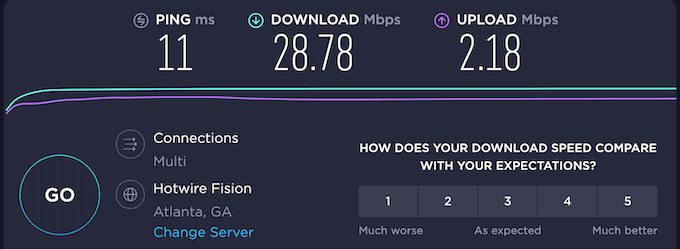Because the definitions out there are wrong
Bandwidth is a common term in the computing and networking world. It’s used so often, in fact, that it’s easy to forget that some people don’t actually understand what it means.
A quick Google search for “what is bandwidth” will turn up two different definitions from the dictionary, neither of which is correct. This article will explain what bandwidth is, how it is measured, and how much you need for different tasks.
What Is Bandwidth?
Bandwidth is defined as the maximum amount of data that can be transmitted through a specified connection within a specified period of time.
This definition is most often used to refer to download and upload speeds given by an internet service provider, or ISP. However, it can refer to any type of connection, including Ethernet, USB, HDMI, and more.

For example, Ethernet is broken down into different categories of cable: 3, 5, 5e, 6, and 6a most commonly. Below is a list of the category of cable and its maximum theoretical bandwidth.
- Cat3: 10 megabits per second
- Cat5: 100 megabits per second
- Cat5e: 1000 megabits per second
- Cat6: 10 gigabits per second
- Cat6a: 10 gigabits per second
Something important to note is that bandwidth does not refer to speed. It refers to data capacity, specifically from one point (or node) in the network to another. If you want to measure the speed of the data transfer, you will want to check the network’s latency (often called ping).
How Is Bandwidth Measured?
Bandwidth is measured by how many bits per second transfer over the network. However, to understand this, you must first understand what a bit is.

A “bit” is the most basic unit of information in a computer. The term is a shortened form of binary digit; in other words, a 1 or 0. You might also know the word “byte.” If you combine eight bits, you make one byte.
Due to advancements in computing and network technology, the number of bits transferred over a network has increased dramatically. In the early days of networking (and as recently as the late 90s to early 2000s), bandwidth could be measured in how many thousands of bits per second, or kilobits.
Now bandwidth is most often measured in millions of bits per second, or megabits. If you live in an area with better connection speeds, you might even see gigabit connections, or billions of bits per second.
Think of a connection like a piece of pipe. Only so much water can travel through that pipe at any given time, and once you reach the maximum amount of water, it’s impossible to fit any more into the pipe. You need a pipe with a larger diameter. That’s the same concept as increasing bandwidth through better connection methods, such as fiber optic lines.

That said, fiber optic (or fiber) connections do not actually utilize a larger diameter, but a better method of transferring data. The original copper wires transferred data through electrical pulses. Fiber optic connections transfer data through pulses of light.
With regard to your ISP, you might pay for a 100 Mbps connection but receive only 75 Mbps. What your plan refers to is the maximum amount of bandwidth available to you, but this can vary depending on time of day, temperature, weather conditions, and more.
You are likely to see lower speeds at 6 PM when more people are home than you might at 3 AM when most people are asleep (and thus overall internet usage is lower).
How Much Bandwidth Do You Need?
Bandwidth requirements differ wildly from person to person. Someone who streams live content such as gameplay or instructional videos will require far more bandwidth than someone that only browses Facebook after work.
To determine how much bandwidth you need, break down your internet usage habits.
- Do you play a lot of online games?
- Do you stream a lot of video content?
- Do you transfer large files on a regular basis?
If you answered “yes” to any of the above questions, then your bandwidth requirements are a bit above average. Thankfully, it’s easy to discover your current bandwidth. Ookla is one of the foremost speed testing companies out there. A quick visit to their site will give you your current latency, download, and upload speed.

Note: Speeds may be lower on Wi-Fi than on a hardwired connection like Ethernet, depending on the type of Wi-Fi card in your laptop or PC. The above results are from a laptop connected through Wi-Fi, where a desktop on an Ethernet connection regular sees 5x these speeds.
According to a 2018 report from the NCTA, the average US download speed is 93.98 megabits per second, nearly double the global average speed of 46.25 megabits per second.
However, the average speed might not be something you can currently reach due to geographic location. In many rural areas, the only available ISPs provide a maximum download speed of 3 megabits per second.
To stream Netflix, you will want download speeds somewhere between 5 Mbps for high-definition video and 25 Mbps for 4K resolution. If you want to stream video games on Twitch, you will want an upload speed of at least 3 Mbps, but the higher you can achieve, the better quality your stream will be.

Remember that upload speeds ten to be somewhere around 1/10 the download speed, so 3 Mbps will likely have a download speed of 30 Mbps or more.
If you only want to watch the occasional Facebook video or listen to music, your bandwidth requirements are much lower. However, higher bandwidth results in a better browsing experience all around.
If you find yourself frustrated at the time it takes to do something online, it might mean you need more bandwidth than you currently have. If this is the case, research your local ISPs and find out what options are available to you.





